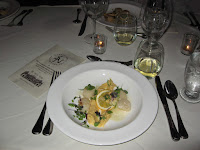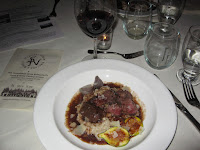We hit the road at 6:00am, in an effort to avoid the typical
Southern California commuter traffic. While we still got stuck in some traffic,
we were soon out of the urban area, and headed up Hwy 5 and eventually Hwy 99.
For those of you not familiar with California, these interstates run through
the center of California, and one of the largest agricultural areas in the
country. We were headed to Lodi. Most of you will automatically start singing
the Creedence Clearwater Revival song in
your head at this point, “I set out on the road/ Seekin' my fame and fortune /
Lookin' for a pot of gold / Thing got bad and things got worse / I guess you
know the tune / Oh Lord, stuck in Lodi again.”
When I moved from Northern California, Lodi was this little
farming town that we drove through on our way to the Sierras. My how things
have changed! Lodi has always been a
farming town, and grape growing dates back to the 1800’s. The California
goldrush hit the mountain communities in 1849, and the demand for wine switched
from Southern California, to Northern California. Vines were planted in the
Lodi area as early as 1850, but it wasn’t until the late 1800’s that the area
started to take off. The most popular grape varieties planted were Zinfandel
and Tokay.
Fast forward to 1986, and the region was established as the
Lodi AVA. It was recognized for the Mediterranean climate with warm days and
cool nights. The delta breezes, coming off the San Francisco Bay, create a
natural air conditioning. The alluvial soils are sandy, mixed with granite, due
to ancient river flows from the Sierra Nevada mountain range. In some areas,
the soil is so sandy, that the vines are not grafted on to protective root
stock (to avoid phylloxera).
 |
| Wine and Roses Hotel |
Before we had left, many people joked about taking a 4-day
vacation to Lodi, and I half wondered myself, if this was a mistake. This wine
tasting weekend came at the recommendation of David Phillips, one of the
brothers/owners at Michael David Winery. We had met at a wine pairing dinner a
couple years back, and he had encouraged me to take our wine club up to the
area. At his recommendation, we booked rooms at the Wine & Roses Hotel. To
say we were pleasantly surprised with the accommodations would be an
understatement. The hotel is an oasis in the middle of farm country. Large
trees, and buildings covered with climbing ivy are just part of the charm. Each
room has a fireplace, and very nicely furnished. Two weddings were taking place
on the weekend we were there, and the grounds are perfect for such events.
On this wine trip, I had arranged for 22 people to attend.
Everything is focused on our Saturday tasting trip, but I also schedule some
type of event on Friday. This Friday, we were scheduled to do a tasting at
Michael David Winery, at 3:30. Since my wife and I arrived early, we headed out
to a winery just down the street from the hotel, named Jessie’s Grove. I chose
this winery because it is one of the oldest in the area, and claims to have
some of the oldest vines still producing grapes.
Jessie’s Grove has 265 acres of vineyards planted. Of these, the oldest vines are Zinfandel and
Cinsault. The Zinfandel, Carignane and Tokay vines date back to 1889, and the
oldest vines are Cinsault, planted in 1886. Only a small portion of the harvest
is used for estate wines. Much is sold off to other wineries in the area.
The tasting room is located in what appears to be an old farm
building. Around the tasting room are numerous photos and memorabilia showing
the history of the property. Wine tasting fees are only $5, and between the two
of us, we tasted most everything on the tasting sheet. We came here for the
Zinfandel, and that is what we bought. Unfortunately, the oldest vine Zinfandel
was sold out already, mostly to club members. We did also pick up the old vine
Cinsault. All the wines were fruit forward, and deep, reflecting the vines
effort to produce limited grape clusters. The production is small, maybe only
6,000 cases, but this historic property is worth a visit.
 |
| Michael David Winery |
From the tiny historic property, we left to meet up with the
rest of our wine tasting group at Michael David Winery. When I lived in the Bay
Area, and drove through Lodi on Hwy 12, The Phillips Fruit stand was along side
the road. Now the fruit stand is still there, but behind it is the large
production winery. Michael David Winery
produces over 800,000 cases of wine. 300,000 of that is Zinfandel. They are the
largest Zinfandel producer in the world.
 |
| Dave Phillips pouring for our group |
Dave Phillips met our group on the outdoor patio, and took
us on a tour of the facility. We started at the colorful “freak show”
fermentation tanks, and continued on to the destemmer and presses, tasting
freshly pressed juice, as well as fermented juice still in the fermenter. Dave
was a great host, and allowed us to taste anything we wanted in the tasting room.
Something has to be said here…in many instances, I find that the larger
producers lose touch with the quality of their wines. Not at Michael David.
They produce consistent quality, even with high production numbers. Their
tasting staff is attentive, and you feel like this is a family operation, even
with the behemoth size. Since many of the Michael David wines can be found in
local retail outlets (including Costco), my purchases were focused on the
higher end, and unusual wines. I purchased the Rage Zinfandel, and some of the
Inkblot wines. Whatever you do, don’t skip this large producer, just because
they are large.
We had dinner planned at Pietro’s Trattoria, in Lodi. Dave
Phillips suggested that we go with the family dinner. Great suggestion. We had eight
people at our table, and had two
appetizers, salad, garlic bread (the best), pasta course, and main entrée, as
well as two local wines (St Amant Barbera
and Bokisch Tempranillo). With tip and tax, the total bill was only
$100/couple, and we had leftovers. The place was packed on a Friday night. The
perfect end to our first day in the area.
Saturday would present us with another adventure. This day
we would be heading up to the Sierra Foothills, and another AVA. Check out our trip to Calaveras County













